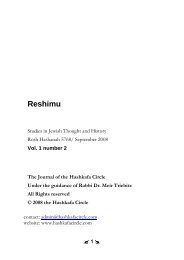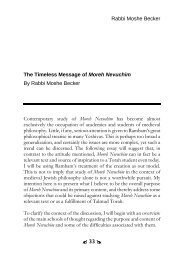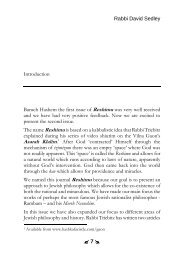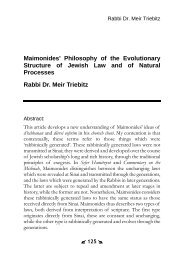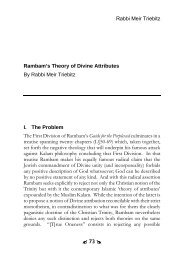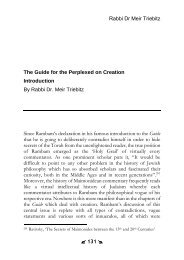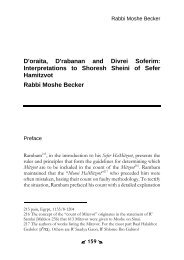Thirteen Midos Shiur 02 Transcription - Hashkafa Circle
Thirteen Midos Shiur 02 Transcription - Hashkafa Circle
Thirteen Midos Shiur 02 Transcription - Hashkafa Circle
You also want an ePaper? Increase the reach of your titles
YUMPU automatically turns print PDFs into web optimized ePapers that Google loves.
The <strong>Thirteen</strong> Middos - <strong>Shiur</strong> 2<br />
Rabbi Meir Triebitz<br />
Hillel felt you could reach people through reason. He believed in the power of persuasion. The middos<br />
created by Hillel are the models of commensurability which allow scholarly exchange between talmidei<br />
chachamim.<br />
Another example in Shabbos 31a is the convert who came to Shamai and asked to be taught the Torah<br />
“while standing on one foot”. Shamai sent him away. Hillel said “I’ll give you a klal; the rest you can<br />
learn.” Hillel was confident of the fact that the Torah can be learned.<br />
We can also see this concept in the final story there, when someone wanted to convert on the condition<br />
that he become the Kohen Gadol. Though Shamai sent him away, Hillel first converted him, then<br />
persuaded him through rational argument to give up his condition of being the Kohen Gadol.<br />
What do we learn from these three stories? Hillel created middos so that the Torah could be debated<br />
rationally. Hillel created formal logical steps - there is a model, there is an equation, there is a rule that<br />
we all agree on, that we know how to use. This allows technique in generating halachos and enables<br />
commensurable scholarly exchange.<br />
These three stories from the Gemara in Shabbos are reflections of Hillel’s approach that there is no<br />
impediment to teaching a person Torah. Hillel believed in the power of persuasion. Shamai held that you<br />
learn something because it is tradition, there is an authority and there is no room for debate. B’nei<br />
Beseira were students of Shamai.<br />
Transformation from tradition to rational debate<br />
The middos introduced by Hillel allow us to rationally persuade a person.<br />
Each story in Shabbos brings a different aspect of logical persuasion.<br />
The Talmud in Eruvin says that the halacha is according to Beis Hillel because they taught the opinion of<br />
Beis Shamai first. They were able to do this because they were confident in their ability to debate, and<br />
that through conversation could reach a common conclusion that everyone agrees to. Hillel’s stance is<br />
that logic can bring us to a commonality of position.<br />
The personality of Hillel (about which there is much written in the agadata) is a function of the fact that<br />
Hillel introduces the seven middos. The seven middos are objective models on the basis of which people<br />
can continue a logical dialogue.<br />
The new paradigm is built upon the previous paradigm – halacha le-Moshe mi-Sinai<br />
We understand the concept of mesorah to mean that the previous generation established a logical basis<br />
upon which I can construct this model; this middah. Even where there is a change of paradigm, the new<br />
paradigm rests upon the old paradigm.<br />
- 8 -



